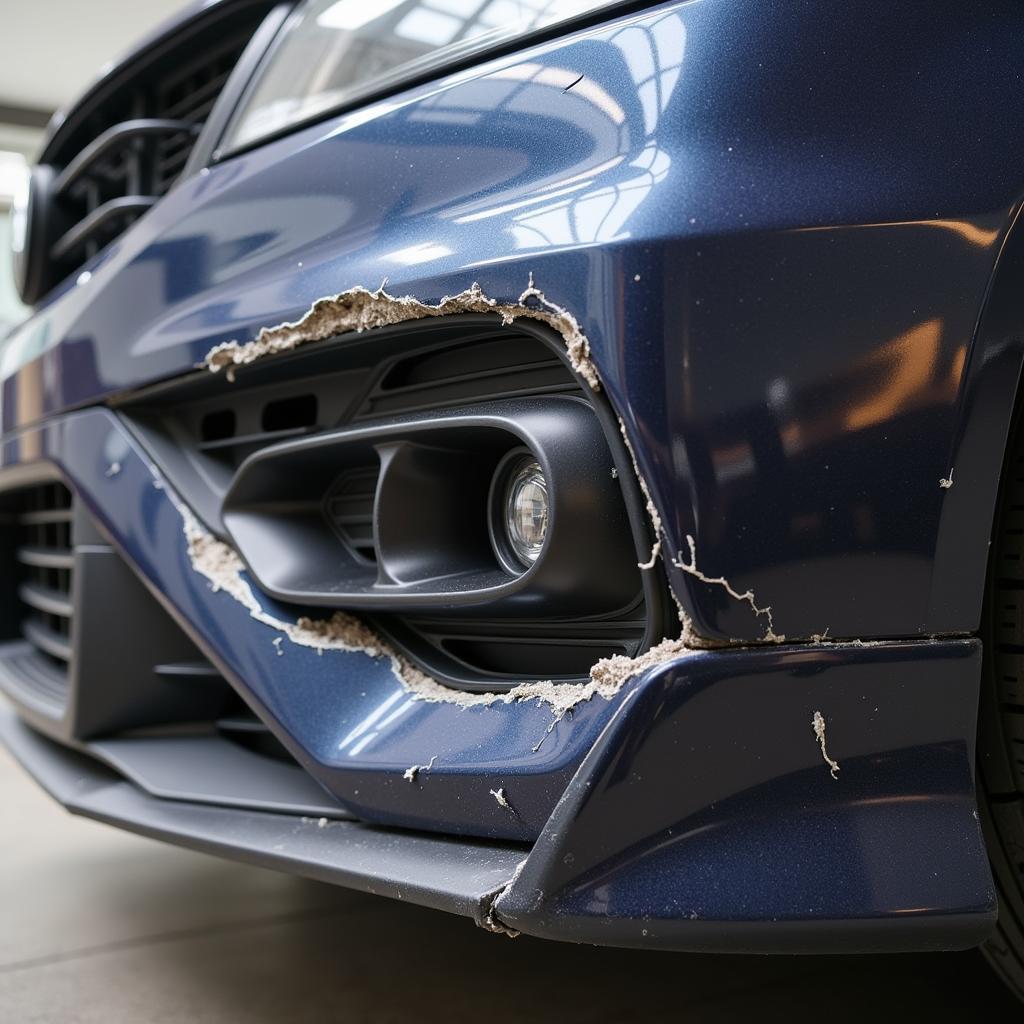Torn or damaged bumpers are a common car problem. Whether it’s a minor crack or a significant tear, fixing a torn plastic car bumper can seem daunting. This guide will walk you through various repair options, from DIY fixes to professional solutions, helping you restore your bumper’s appearance and functionality.
Understanding the Extent of the Damage
Before diving into repairs, assess the damage. A small crack might be fixable with a plastic welder or adhesive, while a large tear might require patching or replacement. Consider the location of the damage too. A tear near a mounting point may weaken the bumper’s structural integrity.
 Close-up of a Torn Plastic Car Bumper
Close-up of a Torn Plastic Car Bumper
Remember, accurately assessing the damage will help determine the best course of action. Is it a simple cosmetic fix, or does it require a more substantial repair? This evaluation is crucial for selecting the right tools and techniques.
DIY Repair Options for Minor Tears
For minor tears and cracks, several DIY options exist. Plastic welders are an excellent tool for fusing the plastic back together. These tools melt the plastic, allowing you to seamlessly blend the edges of the tear. Another option is using plastic bumper repair epoxy. These adhesives create a strong bond and can effectively repair minor damage.
If you are considering repairing leather seats as well, check out this article on can you fix leather seats in car.
Before applying any adhesive or using a plastic welder, clean the damaged area thoroughly with soap and water. This will ensure a strong bond and a smooth finish. Remember to follow the manufacturer’s instructions for both plastic welders and adhesives.
Patching Larger Tears in Your Bumper
Larger tears require a more robust approach. Consider using a plastic patching kit. These kits usually include a mesh patch and adhesive, providing a strong reinforcement for the damaged area. Cut the patch to a size slightly larger than the tear and apply it according to the kit’s instructions. You may also need to sand down any rough edges after the repair for a smoother finish.
For scratches on your car, you might want to learn how to fix scratches on car with compound scratches.
When to Seek Professional Help
While DIY solutions can be cost-effective, some damage necessitates professional repair. If the tear is extensive, near a mounting point, or affects the bumper’s structural integrity, consulting a professional is the safest option. They have the expertise and equipment to handle complex repairs, including bumper replacement if necessary.
Need to fix dents in your car body? Learn more about how to fix dents in car body.
For those dealing with rear bumper damage, there’s a helpful guide on how to fix car rear bumper.
Fixing Car Bumper with Hot Water: Fact or Fiction?
You might have seen videos online suggesting that hot water can fix a dent in a plastic bumper. While hot water can sometimes reshape slightly deformed plastic, it’s generally ineffective for tears or cracks. Learn more about fixing car bumper with hot water credit viralhog.
“Hot water can sometimes work for minor dents, but it’s not a reliable solution for torn bumpers. It’s best to assess the damage carefully and choose the appropriate repair method.” – John Smith, Automotive Engineer at Smith Auto Repair.
Conclusion
Fixing a torn plastic car bumper can range from a simple DIY fix to a more complex professional repair. By understanding the extent of the damage and choosing the right approach, you can restore your bumper’s appearance and ensure its functionality. For further assistance, don’t hesitate to connect with us at AutoTipPro. Our phone number is +1 (641) 206-8880 and our office is located at 500 N St Mary’s St, San Antonio, TX 78205, United States.
“Remember, a well-maintained bumper not only enhances your car’s aesthetics but also plays a vital role in safety.” – Maria Garcia, Senior Technician at Garcia Auto Services.
FAQ
-
Can I paint over a repaired bumper?
Yes, you can paint a repaired bumper after sanding and priming the area. -
What type of adhesive is best for plastic bumpers?
A two-part epoxy specifically designed for plastic is recommended. -
How long does a plastic bumper repair typically last?
With proper preparation and application, a repair can last for several years. -
Can I repair a torn bumper myself if it’s near a mounting point?
It’s generally recommended to consult a professional for repairs near mounting points. -
What is the average cost of a professional bumper repair?
The cost varies depending on the extent of the damage and the shop’s labor rates. -
Is it necessary to replace a torn bumper?
Replacement is only necessary if the damage is severe and beyond repair. -
What are the signs that my bumper needs to be replaced?
Large cracks, significant tears, and damage affecting structural integrity indicate a need for replacement.




Leave a Reply